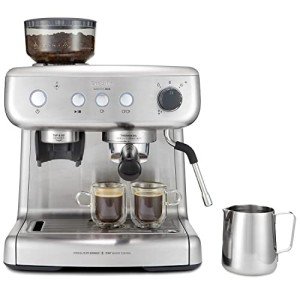20 Reasons Why Stainless Steel Espresso Machines Will Not Be Forgotten
The Art of Italian Espresso Machines: A Brewed Tradition
Italian espresso machines are not just appliances; they are an essential part of Italy's rich coffee culture, representing a mix of artistry, engineering, and style. Coffee connoisseurs all over the world acknowledge the value of high-quality espresso, a staple of Italian life and cuisine. This article explores the history, mechanics, types, and aspects to consider when purchasing an Italian espresso machine, reflecting the depth of this beloved beverage and its developing techniques.
History of Espresso Machines
The espresso machine's advancement go back to the early 20th century in Italy, where coffee was not merely a drink but a necessary social ritual. visit my web page to brew espresso started with basic, stove-top models, gradually evolving into intricate machines that could duplicate the ideal brew.
- 1901— The First Espresso Machine: The first steam-powered espresso machine, called the “Ideale,” was established by Luigi Bezzera. This equipment marked a turning point in espresso developing.
- 1938— The Lever Machine: The introduction of the lever machine made it simpler to manage the pressure used in espresso extraction, boosting taste consistency.
- 1947— The Automatic Machine: Reaching more consumers, Gaggia introduced the first automatic espresso machine, additional popularizing espresso bars.
- 2007— The Digital Age: Technological developments resulted in the birth of fully programmable machines, permitting users to personalize their brewing settings to accomplish a customized coffee experience.
Key Features of Italian Espresso Machines
Italian espresso machines embody accuracy, craftsmanship, and development. Here are some crucial elements that highlight their significance:
Feature
Description
Boiler Type
Determines how heat is produced and preserved. Common types consist of single boiler, dual boiler, and heat exchanger.
Group Heads
Where the coffee is brewed; commercial machines typically have multiple group heads for effectiveness.
Pressure Control
Essential for accomplishing the ideal espresso; most machines operate at 9 bars of pressure.
Frothing Capabilities
The steam wand enables milk frothing, necessary for beverages like cappuccino and latte.
Construct Quality
The products used (stainless-steel, brass, etc) impact resilience and heat retention.
Kinds Of Italian Espresso Machines
Picking the best machine hinges on user preferences, budget, and intended use. Below are the main kinds of Italian espresso machines:
Manual Espresso Machines
- Pros: Offer complete control over the developing procedure, permitting for a personalized touch.
- Cons: Require ability and practice, can be labor-intensive.
Semi-Automatic Machines
- Pros: Provide a balance between automated and manual processes; users manage water flow.
- Cons: Can have a steeper learning curve than fully automatic machines.
Totally Automatic Machines
- Pros: Simplify the developing process with push-button operations; ideal for beginners.
- Cons: May compromise a few of the nuances of manual brewing.
Super-Automatic Machines
- Pros: Grind, tamp, brew, and froth immediately; convenient for busy way of lives.
- Cons: Less control over the brewing variables, potential for a less authentic espresso experience.
Purchasing Guide: Factors to Consider
Selecting the perfect Italian espresso machine can be challenging, however thinking about the following aspects can streamline the decision-making procedure:
- Budget: Italian espresso machines range from affordable to high-end models, so set a budget upfront.
- Usage Frequency: Evaluate how typically you will use the machine; day-to-day users might want a more resilient option.
- Space: Measure your kitchen or counter area; some machines can be big and require adequate clearance.
- Upkeep: Consider ease of cleansing; machines with detachable parts or built-in cleansing features may decrease upkeep.
- User Skill Level: Beginners might choose fully or semi-automatic machines, while skilled baristas can manage manual machines.
- Brand name Reputation: Research brand names understood for quality, such as Breville, Gaggia, and La Marzocco.
Popular Italian Espresso Machine Brands
Italian craftsmanship is renowned for producing a few of the very best espresso machines worldwide. Here are top brand names worth thinking about:
- Gaggia: Known for its home espresso machines and price.
- La Marzocco: A superior brand understood for its commercial-grade machines and innovative technology.
- Rancilio: Renowned for its durable construct and professional-quality machines appropriate for home and commercial use.
- Sage/Breville: Offers advanced features and user-friendly styles, ideal for both beginners and lovers.
Frequently asked questions
What is the distinction between espresso and regular coffee?
Espresso is a concentrated coffee brewed by forcing hot water through finely-ground coffee under pressure. It has a thicker consistency, richer flavor, and higher caffeine concentration than routine coffee.
Can I make milk-based beverages with an espresso machine?
Yes, numerous Italian espresso machines feature a steam wand to froth milk for beverages like coffees, lattes, and macchiatos.
How frequently should I clean my espresso machine?
Regular maintenance is essential. Typically, a comprehensive cleansing is advised every couple of weeks, while descaling ought to be done every 1 to 3 months, depending upon water solidity.
What is the perfect pressure for developing espresso?
The perfect pressure for brewing espresso is around 9 bars. This pressure ensures the ideal extraction of tastes from the coffee grounds.
Are more pricey machines worth the financial investment?
Higher-end machines often make use of better products and technology, supplying improved resilience and more constant outcomes. For severe coffee fans, purchasing a great machine can elevate the espresso experience substantially.
Italian espresso machines are far more than mere brewing gadgets; they are an event of a cultural custom that has actually influenced coffee intake worldwide. With numerous designs readily available to fit any user's requirements— varying from beginners to experienced baristas— there is an Italian espresso machine completely fit for everyone. As you start your espresso journey, understanding the history, mechanics, and choices will enhance your experience and appreciation for this time-honored beverage. Whether you seek to recreate a café atmosphere in your home or refine your brewing method, these machines can providing memorable cups of espresso decorated with the abundant history of Italian coffee culture.
